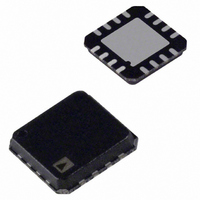AD8295BCPZ-RL Analog Devices Inc, AD8295BCPZ-RL Datasheet - Page 21

AD8295BCPZ-RL
Manufacturer Part Number
AD8295BCPZ-RL
Description
Dual Precision InAmp
Manufacturer
Analog Devices Inc
Datasheet
1.AD8295ACPZ-R7.pdf
(28 pages)
Specifications of AD8295BCPZ-RL
Amplifier Type
Instrumentation
Number Of Circuits
3
Slew Rate
2 V/µs
Gain Bandwidth Product
1MHz
-3db Bandwidth
1.2MHz
Current - Input Bias
200pA
Voltage - Input Offset
60µV
Current - Supply
2mA
Current - Output / Channel
18mA
Voltage - Supply, Single/dual (±)
4.6 V ~ 36 V, ±2.3 V ~ 18 V
Operating Temperature
-40°C ~ 85°C
Mounting Type
Surface Mount
Package / Case
16-VQFN, CSP Exposed Pad
Lead Free Status / RoHS Status
Lead free / RoHS Compliant
Output Type
-
Lead Free Status / RoHS Status
Lead free / RoHS Compliant
Other names
AD8295BCPZ-RL
AD8295BCPZ-RLTR
AD8295BCPZ-RLTR
Power Supplies
A stable dc voltage should be used to power the instrumentation
amplifier. Noise on the supply pins can adversely affect perfor-
mance. See the PSRR performance curves in Figure 14 and
Figure 15 for more information.
A 0.1 μF capacitor should be placed as close as possible to each
supply pin. An additional capacitor, a 10 μF tantalum for the
lower frequencies, can be used farther away from the IC. In
most cases, the 10 μF bypass capacitor can be shared by other
integrated circuits on the same PCB.
INPUT PROTECTION
All terminals of the AD8295 are protected against ESD by
diodes at the inputs. If voltages beyond the supplies are anti-
cipated, resistors should be placed in series with the inputs to
limit the current. Resistors should be chosen so that current
does not exceed 6 mA into the internal ESD diodes in the over-
load condition. These resistors can be the same as those used
for RFI protection. (See the RF Interference section for more
information.)
For applications where the AD8295 encounters extreme
overload voltages, as in cardiac defibrillators, external series
resistors and low leakage diode clamps, such as BAV199Ls,
FJH1100s, or SP720s can be used.
INPUT BIAS CURRENT RETURN PATH
The input bias currents of the AD8295 must have a return path
to common. When the source, such as a thermocouple, cannot
provide a return current path, one should be created, as shown
in Figure 62. Otherwise, the input currents charge up the input
capacitance until the in-amp is turned off or saturated.
Figure 61. Supply Decoupling, REF, and Output Referred to Local Ground
R
G
+IN
–IN
AD8295
IN-AMP
+V
–V
S
S
0.1µF
0.1µF
REF
10µF
10µF
LOAD
V
OUT
Rev. A | Page 21 of 28
RF INTERFERENCE
RF interference is often a problem when amplifiers are used in
applications where there are strong RF signals. The precision
circuits in the AD8295 can rectify the RF signals so that they
appear as a dc offset voltage error. To avoid this rectification,
place a low-pass filter before the input. Figure 63 shows such a
network in front of the instrumentation amplifier. The filter
limits both the differential and common-mode bandwidth, as
shown in the following equations:
where C
CAPACITIVELY COUPLED
C
C
THERMOCOUPLE
f
f
TRANSFORMER
FILTER
FILTER
D
INCORRECT
≥ 10C
Figure 62. Creating an Input Bias Current Return Path
AD8295
+V
–V
AD8295
IN-AMP
(
(
AD8295
+V
–V
+V
–V
CM
IN-AMP
Diff
IN-AMP
S
S
S
S
S
S
C
)
.
)
=
=
REF
REF
REF
π 2
π 2
RC
R
1
2 (
f
C
HIGH-PASS
C
1
D
+
C
C
=
CAPACITIVELY COUPLED
)
2πRC
1
10MΩ
C
C
R
R
THERMOCOUPLE
TRANSFORMER
CORRECT
AD8295
AD8295
AD8295
+V
+V
+V
IN-AMP
–V
–V
–V
IN-AMP
IN-AMP
AD8295
S
S
S
S
S
S
REF
REF
REF











